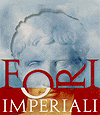The Forum Area
Forum of Caesar
54 B.C. – Gallican conquests;
Caesar's letter to Cicero to acquire neighboring lands of the Roman Forum;
48 B.C. – Farsalo Battle and Caesar's vow to erect the temple of Venus;
September 26th 46 B.C. – Inauguration of the Temple and incomplete
Forum;
March 15th 44 B.C. – Caesar's Assassination
80 A.D. – Fire destroys the Forum;
May 12th 113 A.D. – Trajan has Temple reconstructed;
283 A.D. – during the kingdom of Carinus and Numerian another fire
destroys the Forum, which is reconstructed in a large part by Diocletian.
Complex Area: 160x75 meters

The piazza, in a long rectangular form, had
columnar porticos on the sides with two naves. Meanwhile, the entrance side had only a one
nave portico, probably for the presence of the Chalcidicum- the monumental entrance to the
Curia.
Under the flat ceilings of the lateral porticos were a series of tabernae (shops)
from the Augustus era that were partially reconstructed under Trajan. The shops, of
various sizes, were wedged in the Campidoglio facing Clivo Argentario- the antique street
that connected the Roman Forum to the Campidoglio.
 A semicircular
series of columns facing south-east gave access to a large public lavatory from the Trajan
era and is considered to be the largest in the antique world. A semicircular
series of columns facing south-east gave access to a large public lavatory from the Trajan
era and is considered to be the largest in the antique world.
As an extension to the south-west portico, Trajan also added a structure of pillars with
double naves and two wings running along the edge of the Campidoglio.
According to sources from the 4th century A.D. the Forum was
later used as the Basilica Argentaria. which certainly reflected the name of its
location-Clivo Argentario. At the end of the Forum piazza was the Temple of Venus Genetrix
with eight columns in the front, nine on the sides, but without any columns in the back (periptero
sine postico).
Functions
 The Forum wasn't
used for commercial activity, but used as a meeting place for dealings in public affairs
as well as the noblest activities that were before held in the Roman Forum. The Forum wasn't
used for commercial activity, but used as a meeting place for dealings in public affairs
as well as the noblest activities that were before held in the Roman Forum.
The Basilica Argentaria was probably used as a specialized market selling bronze and
silverware. In later ages the structure was certainly used as a school. The temple's cell
probably also functioned as a museum since several works from celebrated artists have been
found: one of them being the worship statue of Venus sculpted by Arkesilaos-celebrated
artist in Caesar's time. Together with this are preserved paintings by Timomaco of
Bisanzio, six dactylothecae (incised precious stones), and a gold statue of Cleopatra.
Historical Context
The Forum of Caesar, in addition to being one of the most evident monuments of
self-representation of political power, was constructed as an extension to the Roman
Forum. Caesar himself behaved like a greco-oriental sovereign, escorted by a procession of
elephants and, against every republican norm, once received the Senate sitting in the
center of the temple. The dictator also had placed in front the temple a statue of himself
riding Bucefalo, the celebrated horse of Alexander the Great and symbol of absolute power.
The Temple of Venus Genetrix, intentionally placed at the end of the piazza was the
unifying and conclusive element to the architectural complex. This strict centralized
vision corresponded to the ideological function, following the propaganda of the
Hellenistic sanctuaries.
The choice of the Forum site is also significant: the future dictator didn't want to be
far from the central power, represented in the Curia, seat of the Senate. In fact, not
long before Caesar's death, the Senate agreed to reconstruct the Curia on the site.
The Public Lavatories
The semicircular brick structure had a loose stone foundation under the pavement with suspensurae
(small brick pillars) inserted for drainage.
The external area was probably covered with a ring barrel vault, while the central sector
was presumably uncovered to give light and ventilation. In spite of its modest function as
public toilets, the walls were covered in marble- evident today by holes in the walls that
were used to place the slabs.
Travertine corbels supported seats for around 50 people. This is an example of one of the
largest and most elegant hygienic foundations in the antique world.
Graffiti on walls
In the late antique epoch the Basilicata Argentaria was used as a school, as attested by
graffiti of verses from the Aeneid. These are still visible on the plaster of the walls.
It is guessed that one of the teachers was Caecilius Eros. There is not only
graffiti in writing but also a series of comical figures and portraits probably done by
bored students.
Decorative Elements
The rich architectural decoration of the Temple of Venus Genetrix, re-erected by Trajan,
was reconstructed based on both historical sources (over the ages this decoration has
recorded magnificence) and recovered fragments found during the 1930's excavation-
recently renovated and systemized in the inside of the tabernae.
> Forum of Augustus
> Forum of Nerva
> Temple of Peace
> Forum of Trajan
> Trajan's Market
> Presentation of
the operation
> Methodology of the
archeological excavation
> News from the Forum
workshop
> The staff engaged in
recovery |



